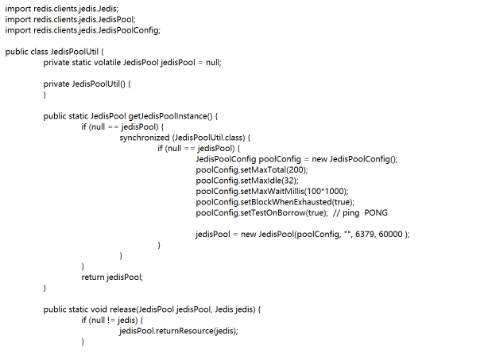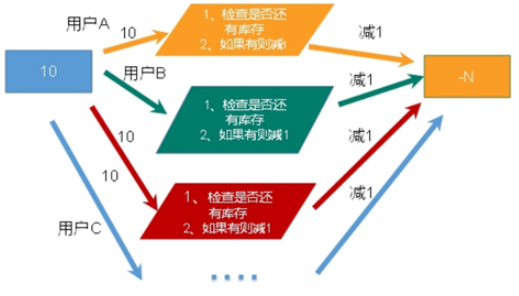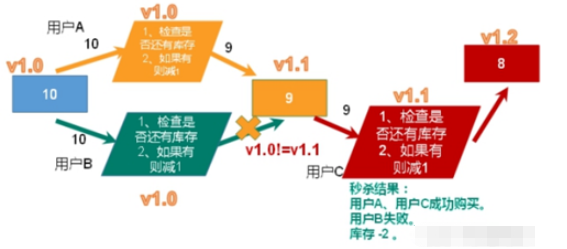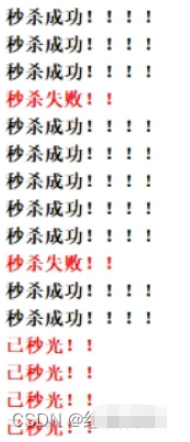 Database
Database
 Redis
Redis
 How to solve the timeout and oversold problems in the flash sale scenario in Redis
How to solve the timeout and oversold problems in the flash sale scenario in Redis
How to solve the timeout and oversold problems in the flash sale scenario in Redis
Timeout
1.Redis connection timeout reason
(1) Configuration issues in the virtual machine
When we test the remote connection to see whether the redis connection is successful, the console The following errors may be reported.
As shown below:

#I get a headache every time I see the red text on the console. . .
The display in the console probably means that the connection timeout caused the failure.
The following three reasons for connection failure are summarized:
The firewall in Linux is not closed and causes failure.
redis needs to be opened.
bind 127.0.01 in redis.conf needs to be commented out, and then protected-mode no needs to be modified.
If you encounter the above problems in the future, please look it up yourself.
(2) Simulate the timeout in high concurrency during redis successful connection
As shown in the figure:

2. Solution
You may find connection timeout problems when using jdbc in MySQL, so we use database connection pools to solve the problem, such as druid, c3p0, etc. In the same way, we can also use the database connection pool in redis.
Save the consumption caused by each connection to the redis service and reuse the connected instances.
Manage connection behavior through parameters
Go directly to the Notepad code!

Link pool parameters:
MaxTotal: Control how many jedis instances a pool can be allocated through pool.getResource() Obtain; if the value is -1, it means no limit; if the pool has been allocated MaxTotal jedis instances, the status of the pool at this time is exhausted.
maxIdle: Controls the maximum number of jedis instances in idle state in a pool;
MaxWaitMillis: Indicates when borrowing a jedis instance, the maximum number of milliseconds to wait. If the waiting time is exceeded, JedisConnectionException will be thrown directly;
testOnBorrow: Whether to check connection availability (ping()) when obtaining a jedis instance; if If true, the obtained jedis instances are all available;
Oversold
1. Flash kill oversold phenomenon
In high concurrency scenarios , multiple threads update the inventory concurrently, resulting in a negative inventory situation.
Look at pictures and imagine:

2. Solution
(1) Use optimistic locking to eliminate users and solve the overselling problem
Above picture:

//增加乐观锁
jedis.watch(qtkey);
//3.判断库存
String qtkeystr = jedis.get(qtkey);
if(qtkeystr==null || "".equals(qtkeystr.trim())) {
System.out.println("未初始化库存");
jedis.close();
return false ;
}
int qt = Integer.parseInt(qtkeystr);
if(qt<=0) {
System.err.println("已经秒光");
jedis.close();
return false;
}
//增加事务
Transaction multi = jedis.multi();
//4.减少库存
//jedis.decr(qtkey);
multi.decr(qtkey);
//5.加人
//jedis.sadd(usrkey, uid);
multi.sadd(usrkey, uid);
//执行事务
List<Object> list = multi.exec();
//判断事务提交是否失败
if(list==null || list.size()==0) {
System.out.println("秒杀失败");
jedis.close();
return false;
}
System.err.println("秒杀成功");
jedis.close(); 

(2) If no changes are monitored in the inventory and the quantity is greater than one, the inventory is reduced by one and the task is executed.
Disadvantages
It is very important to ensure that the inventory of goods is correct, but simply Using a mechanism like WATCH puts too much pressure on the server
And setnx does not have some advanced features of distributed locks, so we still have to pass it through Build manually.
What the lock does It is to set a randomly generated 128-bit UUID to the value of the bit key to prevent the lock from being acquired by other processes.
Meet the conditions (judge the uuid value) Just delete it in redis through delete, rs.delete(lockname)
In addition, when other users hold the same lock, due to the different uuid, other people's locks will not be released by mistake after verification.
In the previous locks, there was also such a problem. For example, a process suddenly crashed after holding the lock, which would cause the lock to be unable to be released
and other processes could not hold the lock and continue working. In order to solve this problem Question, you can add the lock timeout function when acquiring the lock.
The above is the detailed content of How to solve the timeout and oversold problems in the flash sale scenario in Redis. For more information, please follow other related articles on the PHP Chinese website!

Hot AI Tools

Undresser.AI Undress
AI-powered app for creating realistic nude photos

AI Clothes Remover
Online AI tool for removing clothes from photos.

Undress AI Tool
Undress images for free

Clothoff.io
AI clothes remover

Video Face Swap
Swap faces in any video effortlessly with our completely free AI face swap tool!

Hot Article

Hot Tools

Notepad++7.3.1
Easy-to-use and free code editor

SublimeText3 Chinese version
Chinese version, very easy to use

Zend Studio 13.0.1
Powerful PHP integrated development environment

Dreamweaver CS6
Visual web development tools

SublimeText3 Mac version
God-level code editing software (SublimeText3)

Hot Topics
 1664
1664
 14
14
 1423
1423
 52
52
 1321
1321
 25
25
 1269
1269
 29
29
 1249
1249
 24
24
 How to build the redis cluster mode
Apr 10, 2025 pm 10:15 PM
How to build the redis cluster mode
Apr 10, 2025 pm 10:15 PM
Redis cluster mode deploys Redis instances to multiple servers through sharding, improving scalability and availability. The construction steps are as follows: Create odd Redis instances with different ports; Create 3 sentinel instances, monitor Redis instances and failover; configure sentinel configuration files, add monitoring Redis instance information and failover settings; configure Redis instance configuration files, enable cluster mode and specify the cluster information file path; create nodes.conf file, containing information of each Redis instance; start the cluster, execute the create command to create a cluster and specify the number of replicas; log in to the cluster to execute the CLUSTER INFO command to verify the cluster status; make
 How to clear redis data
Apr 10, 2025 pm 10:06 PM
How to clear redis data
Apr 10, 2025 pm 10:06 PM
How to clear Redis data: Use the FLUSHALL command to clear all key values. Use the FLUSHDB command to clear the key value of the currently selected database. Use SELECT to switch databases, and then use FLUSHDB to clear multiple databases. Use the DEL command to delete a specific key. Use the redis-cli tool to clear the data.
 How to read redis queue
Apr 10, 2025 pm 10:12 PM
How to read redis queue
Apr 10, 2025 pm 10:12 PM
To read a queue from Redis, you need to get the queue name, read the elements using the LPOP command, and process the empty queue. The specific steps are as follows: Get the queue name: name it with the prefix of "queue:" such as "queue:my-queue". Use the LPOP command: Eject the element from the head of the queue and return its value, such as LPOP queue:my-queue. Processing empty queues: If the queue is empty, LPOP returns nil, and you can check whether the queue exists before reading the element.
 How to configure Lua script execution time in centos redis
Apr 14, 2025 pm 02:12 PM
How to configure Lua script execution time in centos redis
Apr 14, 2025 pm 02:12 PM
On CentOS systems, you can limit the execution time of Lua scripts by modifying Redis configuration files or using Redis commands to prevent malicious scripts from consuming too much resources. Method 1: Modify the Redis configuration file and locate the Redis configuration file: The Redis configuration file is usually located in /etc/redis/redis.conf. Edit configuration file: Open the configuration file using a text editor (such as vi or nano): sudovi/etc/redis/redis.conf Set the Lua script execution time limit: Add or modify the following lines in the configuration file to set the maximum execution time of the Lua script (unit: milliseconds)
 How to use the redis command line
Apr 10, 2025 pm 10:18 PM
How to use the redis command line
Apr 10, 2025 pm 10:18 PM
Use the Redis command line tool (redis-cli) to manage and operate Redis through the following steps: Connect to the server, specify the address and port. Send commands to the server using the command name and parameters. Use the HELP command to view help information for a specific command. Use the QUIT command to exit the command line tool.
 How to implement redis counter
Apr 10, 2025 pm 10:21 PM
How to implement redis counter
Apr 10, 2025 pm 10:21 PM
Redis counter is a mechanism that uses Redis key-value pair storage to implement counting operations, including the following steps: creating counter keys, increasing counts, decreasing counts, resetting counts, and obtaining counts. The advantages of Redis counters include fast speed, high concurrency, durability and simplicity and ease of use. It can be used in scenarios such as user access counting, real-time metric tracking, game scores and rankings, and order processing counting.
 How to set the redis expiration policy
Apr 10, 2025 pm 10:03 PM
How to set the redis expiration policy
Apr 10, 2025 pm 10:03 PM
There are two types of Redis data expiration strategies: periodic deletion: periodic scan to delete the expired key, which can be set through expired-time-cap-remove-count and expired-time-cap-remove-delay parameters. Lazy Deletion: Check for deletion expired keys only when keys are read or written. They can be set through lazyfree-lazy-eviction, lazyfree-lazy-expire, lazyfree-lazy-user-del parameters.
 How to optimize the performance of debian readdir
Apr 13, 2025 am 08:48 AM
How to optimize the performance of debian readdir
Apr 13, 2025 am 08:48 AM
In Debian systems, readdir system calls are used to read directory contents. If its performance is not good, try the following optimization strategy: Simplify the number of directory files: Split large directories into multiple small directories as much as possible, reducing the number of items processed per readdir call. Enable directory content caching: build a cache mechanism, update the cache regularly or when directory content changes, and reduce frequent calls to readdir. Memory caches (such as Memcached or Redis) or local caches (such as files or databases) can be considered. Adopt efficient data structure: If you implement directory traversal by yourself, select more efficient data structures (such as hash tables instead of linear search) to store and access directory information



